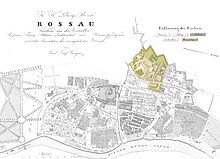Himmelpfortgrund
| Himmelpfortgrund | |
|---|---|
| coat of arms | map |
 |
 |
The Himmelpfortgrund was an independent municipality ( suburb ) until 1850 and is now a district of Vienna in the 9th district of Alsergrund . The Himmelpfortgrund bordered the Lichtental , the Thurygrund , Michelbeuern and the Währinger and Nussdorfer Linienwall .
The historicist Canisius Church with its two 85 meter high towers and the private hospital Sanatorium Hera are located on Himmelpfortgrund . The Austrian composer Franz Schubert was born in 1797 on Himmelpfortgrund. His birthplace is one of the apartments of well-known musicians in Vienna managed by the Wien Museum .
The name Himmelpfortgrund is derived from the Himmelpfortkloster, from which the former owner of the Pötzleinsdorf estate, Jakobine Pestlautz (née von Landtsperger), separated part of the territory according to the will of July 10, 1638 when the line wall was built, but the name Sporkenbühel still has a few Get time. In September 1783, the Lower Austrian provincial government informed the prince-archbishop consistory that the monastery would be abolished with the highest resolution. Only after this abolition did the Himmelspfortgrund develop. In 1825 the magistrate bought the Himmelpfortgrund for 62,000 guilders from the Imperial and Royal State Property Administration and thus acquired the local authority and land authority.
literature
- Felix Czeike : Historisches Lexikon Wien , Vienna 1992–2004.
Web links
Individual evidence
- ^ Himmelpfortgrund (suburb) in the Vienna History Wiki of the City of Vienna
Coordinates: 48 ° 13 ′ 37 ″ N , 16 ° 21 ′ 6 ″ E
